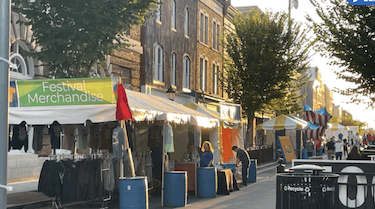Mark’s Score 8.7
The Maryland Folk Festival is an off-shoot of the National Folk Festival which was held in Salisbury four times over a five-year period between 2018 and 2022. Due to the outbreak of COVID, Salisbury has been the only city to host the National Folk Festival for four consecutive years. The national festival ran for three days in early September, it attracted 70,000+ visitors, and had dozens of acts (domestic and international) across four stages in downtown Salisbury.
The Maryland Folk Festival has been moved to later in the month (September 20-22), which is a blessing, it is just too hot to hold the festival in early September. As I get older, I am far less able to tolerate extreme heat. By late September the temperatures have fallen below 85oF (29oC) which makes it perfect weather for outdoor events.

Though the Maryland Folk Festival acts are still distributed on four stages over three days (just like the National), the event is more intimate. Both the performing spaces and the downtown footprint of the event is smaller than the national festival. Where the national festival attracted tens of thousands, the Maryland festival attracts thousands. There are fewer international performing acts, and more local acts.
In many ways, all of these changes make for a more enjoyable experience. I was a volunteer at the national festival, and though it was fun it seemed a bit overwhelming. There were too many things going on, the crowds were too large, and some people had to park miles from the event. All of those issues have disappeared with the smaller Maryland Folk Festival.
The Maryland festival also differs from the national in that there is a greater emphasis on local storytelling, local poets, and local crafts. Don’t get me wrong, I am all for storytelling and poetry but I can’t help feeling that an opportunity was missed here in telling the story of the Eastern Shore of Maryland. I am delighted to see that Harold Whitelock is telling the story of skipjack captains. The skipjack has played a large role in the history of the Chesapeake Bay. It is a story worth hearing. But the festival presents an opportunity to tell the stories that shaped Maryland’s Eastern Shore. Where are the decoy carvers? Duck hunting on the Chesapeake was the catalyst for the Eastern Shore’s most important art form, decoy and waterfowl wood carving. How can you have a folk festival on the Chesapeake Bay and not talk about duck hunting and decoy art? The same goes for the oystermen. The Chesapeake Bay is rightly famous for its oysters, and oystering has played a large role in the history and economy of the Eastern Shore.
The musical acts this year cover a wide range of genres from gospel and blues, to rock and mariachi. The majority of the acts come from the Delmarva Peninsula with a couple of renowned acts from outside the region.

Leave a Reply